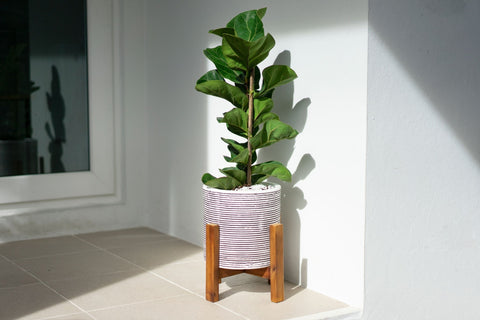
Better known as rubber plants, fig trees, or the fiddle-leaf fig, Ficus trees are most common around Southeast Asia and the Indian subcontinent. Known for their bright emerald leaves and unassuming appearance, these tiny trees can get pretty big, reaching up to 70 feet outdoors! Indoors, your Ficus will make a lovely, long-term addition to your home, especially when accompanied by an artsy pot and some bright light. Outdoors, many people like to prune their Ficus as ornamental landscape trees.
Toxicity
All ficus varieties contain toxic sap, which can cause skin irritation and rashes. If eaten, your pets may experience Ficus poisoning. Symptoms include drooling, decreased appetite, vomiting, diarrhea, and nausea. Contact poison control and a doctor immediately if you think your pet or child has eaten any part of your Ficus.

General Care
Ficus trees tend to be picky and require highly specific conditions to thrive. If it’s struggling, its leaves will drop– usually because one of its basic needs isn’t met.
Light
Ficus trees prefer bright, indirectly sunlight, but some can tolerate direct light if raised with it. To ensure your Ficus is getting plenty of sunlight, place it near an east or south-facing window. Outdoors, keep your Ficus near the east or north side of your home. If your Ficus isn’t getting enough sunlight, its leaves will fall.

Ficus trees prefer bright, indirect sunlight, but some can tolerate direct light if raised with it.
Photo by skaman306
Soil
For soil, you’ll need something that has good drainage and lots of nutrients. We recommend using a soil mix that contains standard soil aerators like peat, perlite, or coir. To ensure your Ficus’ soil has plenty of nutrients, look for soil mixes that contain extra nutrients– just avoid any mixes for plants that need acidic soil– Ficus trees prefer a neutral pH.
Water
You’ll only need to water your Ficus once every 1 to 2 weeks when the top two inches of soil are dry. When you water, be sure to water deeply by using a single-hole watering can. After watering, always make sure any excess water drains completely from your pot before putting it away. If you live somewhere dry, mist your Ficus often to give it some ambient moisture.

Watering Ficus once every 1 to 2 weeks when the top two inches of soil are dry.
Photo by Westend61
Temperature and Humidity
Ficus trees may not need much water in their soil, but they do need lots of water in the air! Keep the humidity around your Ficus at a minimum of 60% to ensure your tree is happy and healthy. To control humidity, mist your plant often, use a humidifier, or place your Ficus’ pot over a bed of pebbles and water.
Fertilizer
To fertilize, we recommend using slow-release pellets once a month during the spring and summer and once every two months in the fall and winter. You can also fertilize your Ficus using compost by adding a small layer over your soil during the summertime. Try to avoid using fertilizers that will increase soil acidity.
Potting and Repotting
Ficus trees don’t like to move around, so when you repot them, always put them back in the same place in your home. When you repot, always do so during the growing season in the spring or summer to avoid transplant shock, and be sure to wear gloves and long sleeves to avoid any skin contact with the Ficus’ sap. When you repot, be sure to use a pot that is at least 10% larger than the previous pot, and make sure the pot contains drainage holes. To further improve drainage, use a pot made from porous materials like concrete, terracotta, or unglazed ceramic.

always repot during the growing season in the spring or summer to avoid transplant shock
Photo by visualspace
Blooming
Ficus trees do not bloom indoors, but they do when grown outside! Ficus flowers are usually small and pale yellow or white. Your Ficus may also produce figs, many of which are edible and used in cooking– just make sure your Ficus is one that produces edible fruits before eating any.
To encourage flowering in your Ficus, increase the time it gets in the sun, and mist the plant regularly in the summer.
Pruning and Propagation
When you prune your Ficus, ensure you do so during the growing season, and always wear gloves and long sleeves to avoid touching any sap. To prune, use a clean, sharp pair of shears to cut a branch just before the growth node so more new branches sprout from the stump.

Photo by Irina Zharkova
The best way to propagate your Ficus is through air layering, which starts root growth on branches while they’re still on the tree. To start, use a sharp knife to make a diagonal cut about halfway into your branch, but do not cut all the way through. Then, remove any leaves from the bottom of your branch and dust your leaves with a little rooting hormone to speed up the process. Finally, pack the space inside the cut with moist sphagnum moss, and then surround the cut branch with a small moss ball. Wrap your moss ball in plastic wrap to retain moisture; you should see some root growth within a month. After you see roots, finish cutting off your branch and plant it in a fresh pot of soil.
Common Pests and Complications
Ficus trees are prone to common houseplant pests like aphids, mealybugs, scale, spider mites, and fungal gnats. To treat these pests, we recommend gentle treatments often used for succulents and other sensitive plants.

 Calathea
Calathea Philodendron
Philodendron Air-Purifying Houseplants
Air-Purifying Houseplants Best Houseplants For Beginners
Best Houseplants For Beginners

